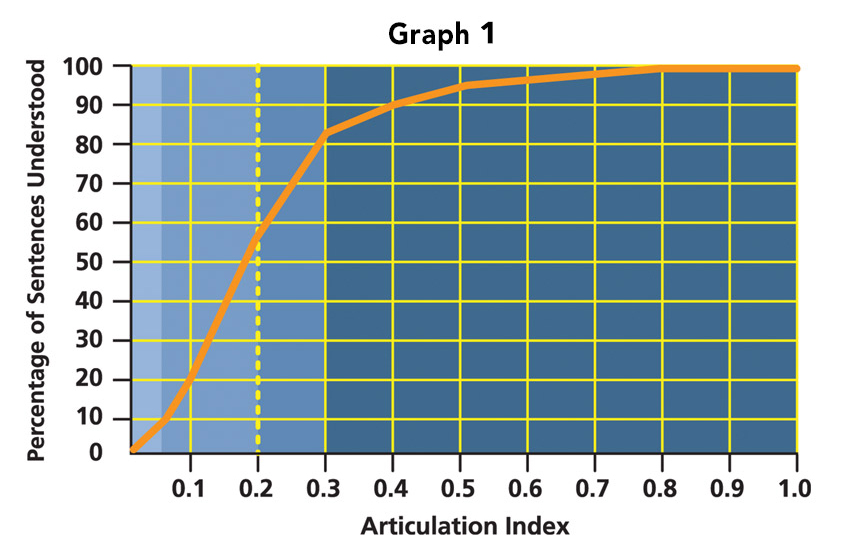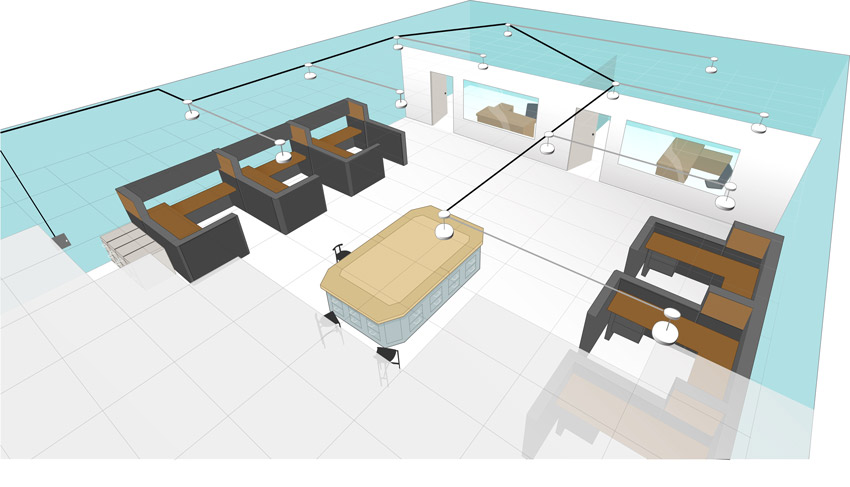Acoustic Privacy
What About the Open Plan?
The topic of workplace satisfaction also emphasizes the need to consider those occupying spaces other than closed rooms. Though some may dismiss the importance of acoustic privacy when designing an open plan, studies show that it has a significant impact on productivity.
For instance, research conducted by Finland’s Institute of Occupational Health shows that unwilling listeners demonstrate a 5 to 10 percent decline in performance when undertaking tasks such as reading, writing, and other forms of creative work. Simply hearing that someone is speaking can disturb concentration, but this problem is greatly magnified when you can clearly understand what they are saying because, if you can follow a conversation, it is much harder to ignore it.
Though an organization might not consider privacy a goal within an open plan, it is impossible to justify increasing disruptions. Taking the steps required to lower speech intelligibility within this type of space increases occupants’ output and reduces error rates.
Assessing Speech Intelligibility
But how do we assess speech intelligibility within the built environment?
To begin, we cannot talk about this subject without getting into the concept of degrees because we do not need to understand every word of a conversation in order for privacy to be violated. Due to the redundancies and patterns in speech, we can follow much of what is said even if we only hear half of it, and particularly if we have previously been part of a similar conversation. Furthermore, private details can be exposed even if we only hear a small part of the discussion.
We must also acknowledge that it is very difficult to subjectively assess degrees of speech intelligibility. For example, a listener would have a hard time indicating with any precision whether they can understand 40, 55, or 70 percent of what someone else is saying.
Fortunately, there are ways to measure and quantify the degree of privacy afforded by a built environment. The Articulation Index (AI) remains the most widely used method. It was developed at Bell Labs in 1921 by Harvey Fletcher as he sought to quantify speech comprehension over telephone lines. During the 1950s, those involved in the speech privacy sciences adopted his invention as a measure of exactly the opposite: how much one could not understand.
To calculate AI, one uses a test signal that includes the frequencies known to specifically impact speech comprehension. This signal is measured at 1 meter from the ‘source’ and again at the ‘listener’ location. The background sound level is also measured at the ‘listener’ location in order to quantify how loud the test signal is relative to it—a value known as the signal-to-noise ratio (SNR). This value is critical, because the lower the SNR, the less the intelligibility and the greater the speech privacy. For AI, SNR is measured in each of 15 frequency ranges (from 200 to 5,000 Hz). Each of these ranges is weighted according to the degree to which it contributes to speech comprehension. The final AI value ranges from 0 (where conversation is completely unintelligible) to 1.0 (where everything is heard and understood).
AI ratings are challenging to interpret in a meaningful way so studies have been done to correlate them to subjective ‘privacy’ categories; however, the value of these groupings is somewhat diluted by the wide range of comprehension within each one. ‘Confidential’ privacy ranges from 0 to 0.1, ‘normal’ from 0.1 to 0.2, and ‘marginal’ from 0.2 to 0.3. If AI is above 0.3, there is effectively no privacy.

Image courtesy of KR Moeller Associates Ltd.
The relationship between Articulation Index (AI) and intelligibility is not linear. For example, a value of 0.5 means that a listener can understand approximately 95 percent of a conversation, not 50 percent. A very low AI value is required for true privacy.
As shown in Graph 1, the relationship between AI and actual comprehension is not linear. On a 0-1.0 scale, many would expect a value of 0.5 to mean that a listener would understand 50 percent of a conversation, but—as is clear from the graph—they would actually understand approximately 95 percent. The shaded areas along the left of the graph show the confidential, normal, and marginal privacy ranges, indicating just how low an AI is required for true privacy.
A more recent arrival on the acoustical scene is a metric called the Privacy Index (PI). PI is based on AI, in that it is calculated as 1 minus the AI value, multiplied by 100, and expressed as a percentage; in other words, 1 - AI x 100 = PI (%).
However, PI can be misleading. Part of the problem likely stems from its use of the word ‘privacy,’ which can cause users to come to the wrong conclusion about the rating’s meaning. The fact that it is expressed as a percentage creates even more potential for confusion. For example, with an AI of 0.3, you arrive at a PI of 70 percent. If you refer to Graph 1, the reason to avoid this metric is obvious. When told the PI is 70 percent, most people would assume that they would only understand 30 percent of what is being said. In reality, you would understand nearly 85 percent. Therefore, building professionals should be cautious when investigating acoustical solutions and interpreting related PI statements.
How Sound Travels
In order to design the built environment for acoustic privacy, it is also important to understand the three ways in which sound—and, hence, voice—travels to a listener.
Sound follows a direct path when it travels uninterrupted from the source to the listener or penetrates a barrier between them, such as a wall. This transmission path contributes the most to high levels of speech reaching the listener. However, it can also travel on a reflected path. This type of transmission occurs when sound bounces off of the various surfaces within the space, such as the floors, ceilings, walls, and furniture. Finally, sound can travel in a diffracted path—that is, it can bend around obstacles. This pathway is generally less significant than the first two.
Because speech travels in these various ways, it can be difficult to contain. Several methods must be utilized because no single technique can sufficiently address all transmission pathways.
Designing For Acoustic Privacy
Traditionally, acoustic professionals have used a multipronged approach called the ABC Rule, which stands for absorb, block, and cover. While most people are well-acquainted with the first two strategies—using walls, doors, workstations, and a well-planned layout to physically block voices and noises, as well as the benefits of installing ceiling tiles, wall panels, and soft flooring to absorb them—fewer understand cover, often leading to over-specification of physical construction, increased costs, and reduced flexibility, with nonetheless unpredictable results.
Given the critical role background sound plays in achieving acoustic privacy, it is advantageous to turn the ABC Rule on its head and begin with ‘C’ instead.
‘C’ involves using a sound-masking system to control the minimum background sound level. Though many compare this technology’s output to that of softly blowing air, it is specifically engineered to cover the range of frequencies in human speech, improving privacy. The sound also covers up incidental noises or minimizes their disruptive impact on occupants by reducing the amount of change between baseline and peak levels within the space. This is a type of effect with which most people are familiar. Everyday examples include the drone of an airplane engine, the murmur of a crowd in a busy restaurant, the hum of highway traffic, and the rustling of leaves in the wind. All have the potential to mask sounds a listener would otherwise hear.

Image courtesy of KR Moeller Associates Ltd.
A sound-masking system consists of a series of electronic components and loudspeakers that distribute a sound specifically engineered to balance acoustic control with occupant comfort.
Due to improvements in construction materials as well as quieter equipment, the background sound level in the majority of facilities is too low. The pin-drop conditions allow occupants to easily hear conversations occurring at a distance and even from within closed rooms. Though they typically describe their workplace as ‘noisy,’ the root of the problem is that it is, in fact, too ‘silent.’ Put another way, the absence of continuous background sound makes noises and conversations easier to hear.
Unless a sound-masking system is implemented—as well as professionally tuned and its performance verified post installation—a facility’s minimum background sound level is unknown. HVAC and other mechanical systems are sometimes thought to provide masking, but one cannot reasonably expect this type of equipment to deliver a consistent level over time or space. Even if well designed, its output is only governed in that it is not to exceed maximums defined by the American Society of Heating, Refrigerating, and Air-Conditioning Engineers in the 2013 ASHRAE Handbook—Fundamentals. Unlike masking technology, it cannot control the minimum background sound level or generate a spectrum conducive to speech privacy.
Accordingly, ASTM E1374: Standard Guide for Open Office Acoustics and Applicable ASTM Standards was recently revised. The discussion of HVAC noise in the newly released ASTM E1374-18: Standard Guide for Office Acoustics and Applicable ASTM Standards pertains only to limiting maximum noise levels rather than using this equipment for masking. Further, a sound-masking system is identified as the only viable source of a continuous minimum background sound level. As the title change suggests, this standard’s scope has also been broadened; it now applies to private offices and conference rooms, not only to open plan.
Mind the Gaps
Generally speaking, an occupant’s expectation of acoustic privacy is higher in closed rooms than within an open plan. However, many continue to exclude sound masking from private offices and meeting rooms, primarily in the belief that closed spaces are afforded sufficient speech privacy and noise control via physical isolation. By the same token, when a closed room fails to provide this quality, it is blamed on deficiencies in its design, construction, and/or maintenance.
While they might be contributing factors, this failure cannot solely be attributed to cracks in the walls’ armor because speech privacy is not determined by isolation alone. As described earlier—and set out in ASTM E2638: Standard Test Method for Objective Measurement of the Speech Privacy Provided by a Closed Room—a person’s ability to clearly understand a conversation is not only dependent on the level of the speaker’s voice but on the background sound level in the listener’s location.
Traditional closed-room construction attempts to provide privacy by simply reducing the signal. Speech privacy levels fluctuate from wall assembly to wall assembly, depending on their performance in the frequencies used to calculate the sound transmission class (STC), their site-tested apparent STC (ASTC) as opposed to STC rating, the inconsistent noise level and spectrum the HVAC system generates, and various flanking paths—gaps along the window mullions, ceiling and floors, as well as through the plenum, ductwork, return air grills, and open doors. If a solution has not been implemented to control the minimum background sound level in adjoining areas and it is lower than the sounds passing through the wall or via leakages, conversations will still be heard and potentially intelligible.
With advances made in sound-masking technology, a minimum background sound level is now a readily deliverable component of architectural acoustic design. Using it—even to apply a level as low as the 30 A-weighted decibels (dBA) on which STC ratings, and hence wall choices, are based—allows the expected degree of speech privacy to be more reliably achieved.
One also has the opportunity to increase the minimum background sound level if the partition construction fails to live up to its rating. The level traditionally recommended in most closed rooms is 40 to 45 dBA, leaving a range of adjustment at the facility manager’s disposal.









